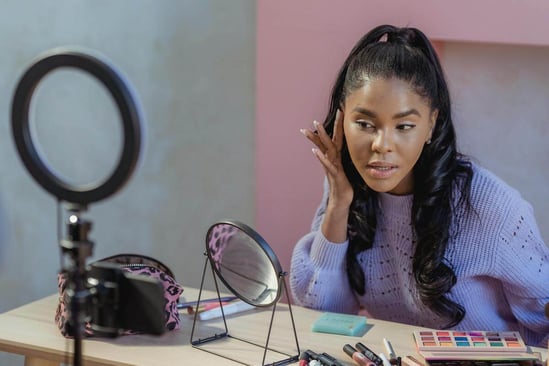
Social platforms are built on sharing beautiful images and videos, curated specially to create envy and inspire desire. The beauty industry is built on making people look and feel their best.
Beauty ecommerce and social media are the ideal marriage between consumer goods and easy purchasing, a way to remove the friction between customer and brand and encourage more loyalty and spending.
A Match Made in Beauty Ecommerce Heaven
Leading digital-savvy beauty brands are capitalizing on the rise of beauty ecommerce with features like Checkout on Instagram and TikTok Shop, which let brands combine the benefits of social media apps with an in-app checkout experience.
Instagram and TikTok aren’t the only social media platforms that have implemented direct-to-consumer (D2C) strategies and capabilities. Pinterest’s “buyable pins” have white dots highlighting different parts of the look; when they’re ready to buy, customers click through to your site to check out. Facebook has also enabled shopping directly from a brand’s page, with a prominent “buy now” button front and center.
If you want to harness social commerce for your beauty brand, take inspiration from these leading brands’ past campaigns. They know how to use social media to grow sales, connect with buyers, communicate their brand values, and win new customers.
Kylie Cosmetics: The Power of Influencers
Unsurprisingly, Kylie Jenner’s own line of cosmetics — which launched with a bang and a set of lip kits in 2015 — capitalized on the rise of social commerce. The digital-first brand knows how to tap into the increasing power of influencers to sell beauty products.
Kylie Cosmetics makes the most of all Instagram has to offer, both in terms of getting influencers involved and in using the power of Stories to preview and promote new products.
Glossier: The Power of Engagement
Glossier has described itself as a “content-first” company and social media is a huge part of that strategy. Its Instagram channel is integrated into the main brand website; it features sneak peeks of new releases and influencer content, but a large percentage of its content is user-generated.
Understanding that social media is first and foremost built on communities, Glossier’s social commerce strategy revolves around featuring the audience’s own photos and feedback; it shows the brand is listening and builds loyalty with consumers. Fans have even shaped product design, with packaging and labels specifically designed to look good in photographs.
Fenty: The Power of Inclusivity
Fenty — owned by singer Rihanna — is built on a “beauty for all” concept. Its foundation comes in 50 different shades which set the scene for social content that is inclusive, body-positive, and diverse.
Its content is also inclusive: Fenty makes the most of everyday fans as well as influencers and models, a strategy that has attracted 12.9 million Instagram followers.
YouTube tutorials, Instagram stories, TikToks, and more celebrate all genders, all body types, and all colors. It’s a strategy that drives huge loyalty in its fanbase, priming customers to be ready for every new product launch.
Dollar Shave Club: The Power of Social Proof
Dollar Shave Club gained popularity with a YouTube video that quickly went viral, showcasing the brand’s storytelling nous.
Since that launch, Dollar Shave Club has used social media to prove it knows its audience intimately and provides something rare in men’s grooming: something relatable.
Posts are hyper-focused on the value proposition, are easily shareable, and every word has a purpose. No opportunity is wasted, and it’s helped Dollar Shave Club lead the rise of social commerce.
Sephora: The Power of Innovation
A look at the leading beauty brands in the digital world wouldn’t be complete without mentioning Sephora. Long a leader in both ecommerce and leveraging emerging technologies, Sephora knows how to make digital and social commerce a true experience.
The brand’s digital marketing team leverages techniques such as quizzes to learn about the audience and deliver personalized recommendations, while not being afraid to trial emerging tech such as artificial intelligence (AI) and chatbots to further engage potential customers both in-store and online.
How Beauty Brands Can Harness the Rise of Social Commerce
Beauty products have been omnipresent on social media for several years, and if your brand isn’t already on there you risk being left behind. The rise of social commerce means that the digital shelf is the new battleground for beauty dollars.
According to Salsify’s “2024 Consumer Research” report, 34% of consumers recently purchased an item from social media, and 21% were inspired by social media influencers to make a purchase.
Winning consumers over takes continuous effort and constant advancement. The world of digital retail is ever-changing, so beauty brands must follow the three principles for winning on the digital shelf: engage shoppers everywhere; execute commerce strategies fast; and be your customers’ best partner.
Today’s consumers will touch your brand multiple times over multiple platforms before making a purchase. It’s imperative to use social commerce capabilities to build the relationship, communicating directly with fans to drive loyalty and win both hearts and minds.
Ensure consistency of messaging and approach across all of these platforms by using a product experience management (PXM) platform that can unite the work of marketing and commerce teams in one place, breaking down silos and enabling rapid expansion into new social channels.
Consumers are used to using social media to research and discover new products; now is the time to evolve that relationship and encourage purchasing directly from social posts.

The Social Commerce Crash Course for Brands
Download this guide to learn the social commerce 101 fundamentals, see examples, and gain tips for launching a winning strategy.
DOWNLOAD GUIDEWritten by: Lauren McMenemy
Recent Posts
What Is the Best Ecommerce Team Structure?
8 Quick Tips for Performance-Driving SEO for Product Pages
10 Brand Examples of Click-Driving Product Images, Videos, and More To Inspire
Subscribe to the Below the Fold Newsletter
Standing out on the digital shelf starts with access to the latest industry content. Subscribe to Below the Fold, our monthly content newsletter, and join other commerce leaders.

